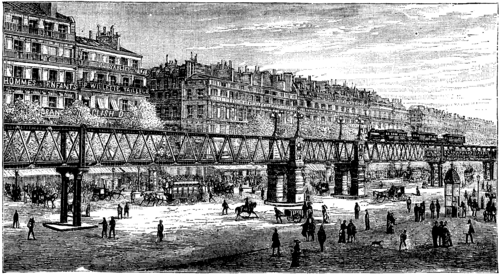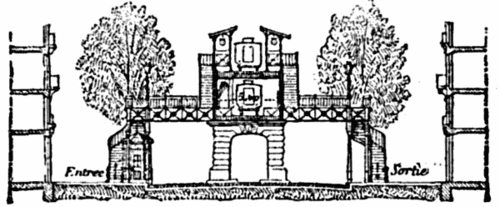Plan For An Elevated Railway At Paris
Description
This section is from "Scientific American Supplement". Also available from Amazon: Scientific American Reference Book.
Plan For An Elevated Railway At Paris
Elevated railways have been in operation for a long time in New York, Berlin, and Vienna, and the city of Paris has decided to have recourse to this mode of carriage, so indispensable to large cities. The question of establishing a line of railways in our capital has been open, as well known, since 1871. During this period of nearly fourteen years this grave subject has at various times given rise to serious discussions, in which the most competent engineers have taken part, and numerous projects relating to the solution that it calls for have been put forth.
The problem to be solved is of the most complex nature, and the engineers who have studied it have not been able to come to an agreement except as regards a small number of points. It may even be said that unanimity exists upon but a single point, and that is that the means of locomotion in Paris do not answer the requirements of the public, and that there is an urgent necessity for new ones. The capital question, that of knowing whether the railway to be built shall be beneath or above ground, is not yet settled; for, up to the present, no project has been prescribed in one direction or the other.
While some extol the underground solution as being the only one that, without interfering with circulation in the streets, permits of establishing a double-track railway capable of giving passage to ordinary rolling stock and of connecting directly with the large lines, others, objecting that such a road could not give satisfaction to the taste of Parisians, and that it would necessitate work out of proportion to the advantages gained, conclude upon the adoption of an open air railway.
Preferences generally are evidently for this latter solution.
We have received from a learned engineer, Mr. Jules Garnier, a project for an elevated railway, which appears to us to be very ably conceived, very well studied out, and which we hasten to make known.
(1.) The system is characterized by the following fundamental points: The up and down tracks, instead of being laid alongside of each other, as in an ordinary railway, are superposed upon two distinct platforms forming a viaduct, which is consequently so arranged as to permit of the laying of one of the tracks at its lower part and of the other at its upper.
(2.) The system of constructing the viaduct is so combined as to be capable of giving passage upon the road to the rolling stock of the large lines during the stoppage of the daily passenger trains.
(3.) The tracks are connected at the extremities by a curve that has the proper incline to compensate for the difference in level between the two, and which has a sufficiently large radius to allow the slope of the track to be kept within the limits admitted. The running of the trains is thus uninterrupted.
(4.) When two lines of different directions bisect one another, a special arrangement permits the passengers from one line to pass to the other by means of what is called a "tangent" station, without the trains of one line crossing the tracks of another, the purpose of which arrangement is to avoid those accidents that would inevitably occur through the crossing of a track by the trains of a transverse line.
(5.) The rolling stock is arranged in a manner that allows the entrance and exit of the passengers to be effected with great promptness.
In ordinary avenues, comprising a roadway and two sidewalks, the elevated railway is placed in the axis of the roadway at a sufficient height to prevent it interfering with the passage of carriages, say 14¾ feet above the surface, while in boulevards or avenues of great width, having contre-allees1 bordered by a double row of trees, it is installed in one of the contre-allees.
In the first case (Fig. 1), the viaduct is wholly metallic, while in the second it comprises masonry arches surmounted by a metallic superstructure. The viaduct is formed of independent spans supported by metallic piers that rest upon masonry foundations (Fig. 2).

Fig. 1. - PROJECT FOR A PARISIAN ELEVATED RAILWAY.

Fig. 2. - LONGITUDINAL ELEVATION.
The line will have three kinds of stations, intermediate, "tangent," and terminal ones. It is at the latter that the two superposed lines are connected by the circular inclined plane.
The waiting platforms of the intermediate stations will be formed simply by the widening of the span corresponding to the station. Access to these platforms will be had by stairs running up from the edge of the sidewalk. The passengers will make their exit by means of corresponding stairs on the opposite side. (Figs 3 and 4.)

Fig. 3. - A STATION.

Fig. 4. - TRANSVERSE SECTION OF STATION.
The tangent stations are placed at the meeting point of two lines, which, instead of crossing each other, are bent inward like an X, the two parts of which will be tangent to the central point. Through such arrangements the running of the trains will be continuous, and a traveler reaching one of these stations will be able, upon changing train, to take at his option any one of the three other directions.
As may be seen, Mr. Garnier's project presents conditions which are very favorable to the establishment of an elevated road in the interior of Paris. Far from injuring the aspect of the great arteries of our metropolis, the viaduct, as it has been conceived, will contribute toward giving them a still more imposing look. If the beautiful is, as has been said, the expression of the useful, an elevated railway, well conceived, may be beautiful. The project of a subterranean railway is attended with great drawbacks, not only as regards the great expense that it would necessitate, but also the difficulties of constructing it. And there is a still graver objection to it, and that is that it would oblige travelers to move like moles in dark, cold, and moist tunnels. At Paris, where we are accustomed to a pleasant climate and clear atmosphere, we like plenty of air and broad daylight. - La Nature.
[1] Paths parallel with the public walks.
Continue to:


